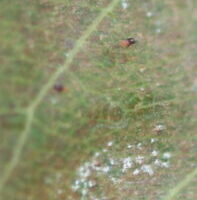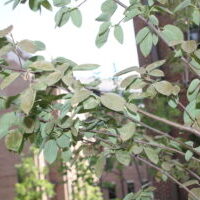 Purdue University - Extension - Forestry and Natural Resources
Purdue University - Extension - Forestry and Natural Resources
Got Nature? Blog
Purdue Landscape Report: Mites are eight-legged arthropods who pierce plant cells to feed on them. Plants that are attacked by mites lose their green color and appear somewhat bronzed. Spider mites will make webs to help them forage on leaves unencumbered by irregular leaf surfaces. The accumulation of webs, and old skins of mites can give heavily infested plants a dusty appearance. This can make plants unsightly and affect their health.

Figure 2. This serviceberry leaf has live European red mites, eggs and old shed skins that accumulate on the leaf.
Lack of rain this summer and fall has spared spider mites from drowning and being washed off leaves during heavy rains. Warm weather in late August and September allowed warm season mites, like two spotted spider mite, European red mite on flowering fruit trees, honeylocust, maple and oak spider mites to flourish. With the daily highs consistently below 85 F, cool season mites like spruce spider mite, boxwood spider mite and southern read mite have been increasing in number.
Now would be a good time to take stock of which plants have spider mites to help you plan your control strategy.

Figure 3. Tap the branches over a white sheet of paper. After giving the mites 10 seconds to grab hold of the paper, turn the sheet sideways to let the debris fall off. Then examine the specs to determine if they are spider mites. A 10X hand lens or smartphone can help you see these small pests.
Cool season mites, including southern red mite, boxwood spider mite and spruce spider mite may require treatment this fall to keep their populations from building. This could be accomplished with a garden hose and a strong stream of water or a 2% solution of horticultural oil or insecticidal soap.
At this point in the season, there is usually no need to spray trees for warm season spider mites. Because most spider mites will winter on trees and shrubs, these mite infested trees can be targeted for a spray of oil during the dormant season. It is important to note that plants with two spotted spider mites will not benefit from an oil spray because they winter in the ground cover. Also, be sure not to spray oil on shrubs with waxy blue leaves. This wax often protects plant leaves from strong winds and sun in the winter.
To view this full article and other Purdue Landscape Report articles, please visit Purdue Landscape Report.
Subscribe and receive the newsletter: Purdue Landscape Report Newsletter.
Resources:
Managing Spider Mite Mayhem with the Purdue Plant Doctor, Purdue Extension Entomology YouTube Channel
Purdue Plant Doctor Website
Spider Mites On Ornamentals, Purdue Extension Entomology Bulletin
Tree Defect Identification, The Education Store
Tree wounds and healing, Got Nature? Blog
Tree Risk Management, The Education Store
Why Is My Tree Dying?, The Education Store
The Woody Plant Seed Manual, U.S. Forest Service
Native Trees of the Midwest, The Education Store
Invasive Species, Playlist, Purdue Extension – FNR YouTube Channel
Report Invasive Species, Purdue Invasive Species
Find an Arborist, International Society of Arboriculture
Subscribe Purdue Extension-Forestry and Natural Resources YouTube Channel
Cliff Sadof, Professor and Extension Fellow
Purdue Entomology

Recent Posts
- From Forest to Classroom – 2024 NRTI Class
Posted: July 26, 2024 in Community Development, Forestry, Urban Forestry, Wildlife - Virtual Tour Brings Forest Management for Birds to Life
Posted: July 19, 2024 in Forestry, How To, Publication, Wildlife - Summer Tree Care – Purdue Landscape Report
Posted: July 16, 2024 in Forestry, Forests and Street Trees, How To, Plants, Urban Forestry - DNR State Deer Biologist Shares Population Ecology of Deer-IFWOA Webinar
Posted: July 12, 2024 in Forestry, Wildlife, Woodlands - Buoys Keep Eye on Great Lake Conditions
Posted: July 11, 2024 in Aquatic/Aquaculture Resources, Great Lakes, How To - ID That Tree: Learn to Identify Conifer Leaf Types
Posted: in Forestry, Forests and Street Trees, How To, Urban Forestry, Wildlife - ID That Tree: Types of Broadleaved Tree Leaves
Posted: July 10, 2024 in Forestry, Forests and Street Trees, How To, Plants, Wildlife - 2024 Turkey Brood Count Wants your Observations – MyDNR
Posted: June 28, 2024 in Alert, Community Development, Wildlife - Case Study: Maple Tree Pests – Purdue Landscape Report
Posted: June 26, 2024 in Disease, Forests and Street Trees, Plants, Spiders, Urban Forestry, Wildlife, Woodlands - Woodland Management Moment: Oak Regeneration – Protecting Seedlings
Posted: June 24, 2024 in Forestry, Urban Forestry, Wildlife, Woodland Management Moment, Woodlands
Archives
Categories
- Alert
- Aquaculture/Fish
- Aquatic/Aquaculture Resources
- Ask the Expert
- Christmas Trees
- Community Development
- Disease
- Drought
- Forestry
- Forests and Street Trees
- Gardening
- Got Nature for Kids
- Great Lakes
- How To
- Invasive Animal Species
- Invasive Insects
- Invasive Plant Species
- Land Use
- Natural Resource Planning
- Nature of Teaching
- Plants
- Podcasts
- Ponds
- Publication
- Safety
- Spiders
- Timber Marketing
- Uncategorized
- Urban Forestry
- Webinar
- Wildlife
- Wood Products/Manufacturing
- Woodland Management Moment
- Woodlands
